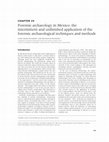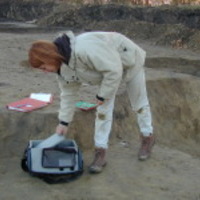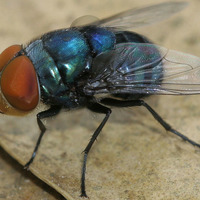Books by Lilia Escorcia Hernandez

Forensic Archaeology, A global Perspective., 2015
To talk about forensic archaeology and its application in Mexico really means to talk about a co... more To talk about forensic archaeology and its application in Mexico really means to talk about a concept which is not well understood and which requires clarification.
The current situation is that the institutions which are in charge of criminal investigation with regard to the search, recording, exhumation and recovery of human remains which have been found either buried or on the surface, and the gathering of other evidence related to a
deposition site, are largely staffed by people who are not qualified or, in the best case, have a very basic knowledge of forensic anthropology and archaeology. As we have seen earlier, there are only a few general Attorney Offices that have (forensic) physical anthropologists and an even lesser number who have personnel formally qualified in archaeology and who participate in forensic casework. In this chapter we prefer not to address the criticisms that can be raised with regard to the lack or misuse of archaeological methods and techniques by people who are not qualified or have received very little professional
training.
Papers by Lilia Escorcia Hernandez
Elaboración de las tablas del grosor del tejido blando facial de los mexicanos por medio de la tomografía computarizada para fines de reconstrucción facial escultórica
Estudios De Antropologia Biologica, Apr 11, 2013
En este trabajo se propone una nueva tecnica de tomografia computarizada, para realizar tablas de... more En este trabajo se propone una nueva tecnica de tomografia computarizada, para realizar tablas del grosor facial. La muestra analizada se integro con 51 individuos mexicanos de los dos sexos. Los resultados obtenidos muestran una clara relacion de la cara con el cuerpo, asi tambien, al aumentar la edad, el tejido blando disminuye su grosor.
Revisión bibliográfica de las técnicas de reconstrucción facial con fines forenses
Estudios De Antropologia Biologica, Apr 11, 2013
Este trabajo se centra en una tecnica forense alternativa para la reconstruccion facial en cadave... more Este trabajo se centra en una tecnica forense alternativa para la reconstruccion facial en cadaveres o esqueletos desconocidos.
Forensic archaeology in Mexico
A global perspective, 2015
Determinación de sexo a través de funciones discriminantes de la rótula en esqueletos humanos contemporáneos provenientes de Caltimacán, Tasquillo, …
Estudios de Antropología …, 2010
... Lilia Escorcia Hernández Esperanza Mayra Lazcano Medina* Bárbara Glendi García Alquicira* ...... more ... Lilia Escorcia Hernández Esperanza Mayra Lazcano Medina* Bárbara Glendi García Alquicira* ... Las fotografías fueron realizadas por Jorge Acevedo Olguín. Se contó con la colaboración general de Marcela Palma Cortés, Adrián Alvarado Viñas, Oliver Tascón y Berta Martínez. ...

Anales de Antropología, 2016
La ontogenia humana, como hecho biológico irrefutable y universal se constituye como unidad de me... more La ontogenia humana, como hecho biológico irrefutable y universal se constituye como unidad de medida temporal de referencia desde Occidente, pero el significado y su representación están íntimamente relacionados con la cosmovisión, la cual cambia de una cultura a otra. En el presente estudio, desde el instrumento conceptual de la hermenéutica analógica, a partir de la revisión de fuentes históricas y estudios científicos diversos, se construyó la propuesta de un modelo ontogenético para el ciclo de vida en Mesoamérica, innegablemente ligado a una concepción particular del tiempo y del espacio que se refleja en la ritualidad y en los mitos. Tal propuesta busca interpretar la divergencia encontrada en el esqueleto de K'inich Janahb' Pakal II de Palenque y en el de otros gobernantes mayas, entre la edad biológica y la edad cronológica del registro epigráfico.











Uploads
Books by Lilia Escorcia Hernandez
The current situation is that the institutions which are in charge of criminal investigation with regard to the search, recording, exhumation and recovery of human remains which have been found either buried or on the surface, and the gathering of other evidence related to a
deposition site, are largely staffed by people who are not qualified or, in the best case, have a very basic knowledge of forensic anthropology and archaeology. As we have seen earlier, there are only a few general Attorney Offices that have (forensic) physical anthropologists and an even lesser number who have personnel formally qualified in archaeology and who participate in forensic casework. In this chapter we prefer not to address the criticisms that can be raised with regard to the lack or misuse of archaeological methods and techniques by people who are not qualified or have received very little professional
training.
Papers by Lilia Escorcia Hernandez
The current situation is that the institutions which are in charge of criminal investigation with regard to the search, recording, exhumation and recovery of human remains which have been found either buried or on the surface, and the gathering of other evidence related to a
deposition site, are largely staffed by people who are not qualified or, in the best case, have a very basic knowledge of forensic anthropology and archaeology. As we have seen earlier, there are only a few general Attorney Offices that have (forensic) physical anthropologists and an even lesser number who have personnel formally qualified in archaeology and who participate in forensic casework. In this chapter we prefer not to address the criticisms that can be raised with regard to the lack or misuse of archaeological methods and techniques by people who are not qualified or have received very little professional
training.